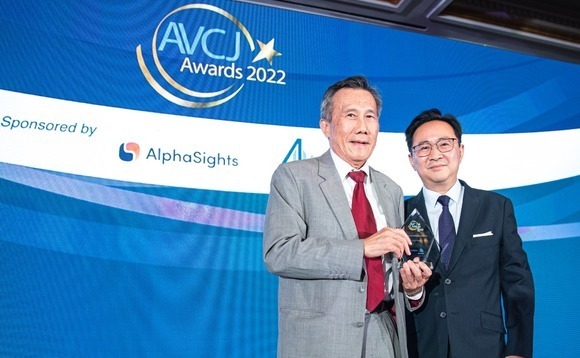
AVCJ Awards 2022: Special Achievement – Kok Peng Teh

Kok Peng Teh spent most of his career at GIC, helping build out what has become one of the world’s largest private equity programmes and nurturing the careers of numerous industry participants
“When people told me that GIC was one of the most sophisticated private markets investors in the world, I usually took it with a pinch of salt. Wouldn’t all GPs say that when they are trying to raise money from you?” observes Kok Peng Teh, who worked for the sovereign wealth fund for 30 years, serving as president of GIC Special Investments from 1999 until his retirement in 2011.
Nevertheless, he attributes the group’s success to two factors: putting in place structures and processes that enabled rigorous screening of investments; and effective development of talent.
Recruitment was difficult in the early days, as Teh discovered when he was tasked with bolstering the private equity team in the early 1990s, but ultimately it became a virtuous cycle. “Once we got some momentum, it became easier to hire people,” he said. “It’s good to know GIC has done well and I’m proud it has done even better after I left. That’s how it should be.”
His contribution is visible not only in the expansion of GIC’s private markets programmes, but also in the talent that went on to populate both the sovereign wealth fund and the wider industry.
Andress Goh, co-CIO of private equity at Allianz Global Investors, and Yar-Ping Soo, head of Asia fund investments at Adam Street Partners, both worked for Teh. Others who came under his tutelage have risen far within GIC, including Lim Hock Tay, now deputy group CIO and group COO, and Eng Seng Ang, who serves as CIO for global infrastructure.
Recruiting at a time when GIC’s private equity exposure was still limited, its compensation packages relatively modest, and few Singaporeans had experience of the asset class, Teh’s solution was to be unorthodox. He pursued government scholars – students who won support for overseas study and went into the civil service on their return – and talent from other industries.
Ang worked in the auditor general’s office before joining GIC, while Tay had studied aeronautical engineering in France and then served in the air force. Arjun Gupta, a later recruit who is now GIC’s president of Europe, previously spent 20 years with Kraft Foods.
“I was willing to take a risk on people who came from different backgrounds but had skillsets that were relevant to private equity and who could bring something extra to the table,” Teh said.
From DC to GIC
His journey to GIC began at the World Bank in 1975. Originally from Malaysia, he completed undergraduate and postgraduate studies in Australia and the UK, respectively, before winning a place on the organisation’s young professionals programme in Washington D.C. He stayed six years and then answered the urge to return to Asia. The Monetary Authority of Singapore (MAS) was hiring.
MAS offered Teh the role of chief economist in 1981. This was also the year GIC was established and mandated to manage a portion of the country’s foreign exchange reserves. He straddled both organisations between 1986 and 1998 – which was not unusual for MAS officials at the time – before formally moving to GIC.
The initial allocation was relatively small and solely in fixed income. Public equities came next, and then GIC formed separate units for private equity – though it was referred to as venture capital – and real estate. Given GIC was unable to invest in Singapore, the US was a natural focal point. The public markets team set up an office in New York and the private markets team went to the Bay Area.
Teh moved into private equity following an internal shake-up in 1990. At the time, with GIC’s exposure to the asset class minimal, he had a team of six based entirely in the Bay Area. Private equity as an industry was still nascent. GIC participated in the debut funds raised by KKR, TPG Capital, and Hellman & Friedman, but passed on Carlyle’s first offering.
“They were Washington guys, and we weren’t sure what they knew about private equity. But we stayed in touch, they showed us some co-investments that worked out well, and it became clear that being the only game in town in D.C. private equity meant they understood government policy and regulation,” said Teh. “We invested in Fund II and it grew from there.”
Having a US base was a competitive advantage for GIC as an Asia LP in that it facilitated face-to-face engagement with managers. Teh also travelled to the US regularly. Once the private equity unit became a standalone division [this predated the formation of GIC Special Investments in 1999, which saw PE moved into a separate company], he chaired the investment committee and had the authority to make commitments up to a certain amount, which reassured GPs.
The relationships that emerged from those early investments in the likes of KKR, TPG, and Carlyle led to a shift in GIC's portfolio in the early 1990s from venture to buyout. Getting into the top VC funds was difficult and quotas tended to be small. Private equity, by contrast, was relatively accessible and GIC could write cheques that were meaningful relative to its overall size. Subsequently, co-investment became a factor as well.
“We waited until we had invested for a few years to see how the funds worked out. If you can get co-investment from a manager that you regard highly it makes sense to do it because you don’t pay management fees or carried interest,” said Teh. “But if you say you’re in then you’re in. You can’t ask for USD 40m and then a few weeks later the investment committee turns it down.”
GIC was happy to convene its investment committee once a week if necessary, which meant it was more fleet of foot than most state pension funds at the time.
Going global
PE investment professionals were dispatched to London to cover Europe in the early 1990s and Asia didn’t appear on the agenda until after the Asian financial crisis when global firms arrived in the region. GIC ended up making direct investments alongside fund commitments and co-investments.
The sovereign wealth fund also became a pioneer in Chinese private equity as one of four anchor investors in CDH Investments’ debut fund. The opportunity emerged after GIC signed up as a founding shareholder in China International Capital Corporation (CICC), which was formed by China Construction Bank and Morgan Stanley in 1995 as the country’s first joint venture investment bank.
“It wasn’t a large investment, maybe USD 7.5m, but it wasn’t about the money as much as getting into something new and strategic and understanding how China worked from the inside,” said Teh, who was one of the original CICC board members. “They had a PE division and I sent one of my staff to be attached to them. He was there for three years and then set up our Beijing office in 1998.”
In 2002, CICC’s private equity division spun out for regulatory reasons. Shanghzhi Wu, who led the team, pitched GIC for a commitment to a USD 100m fund. It put in USD 20m and took a share of the management entity as well. This was one of GIC’s first GP stake acquisitions; years later – mostly after Teh’s retirement – it invested in the likes of TPG, CVC Capital Partners, and Apax Partners.
During his time at GIC, Teh ran into all-too-familiar challenges around rising fund sizes and contracting investment cycles. Managers would return to market so early that it was hard to assess the performance of the previous vintage. At the same time, GIC’s private equity allocation was rising in absolute terms and the team was under pressure to put capital to work again when it came back.
“You might say to a manager, ‘Your return is lower but it’s still better than what I can get in public markets or fixed income, so I’ll continue to invest.’ There is a tension because, at the back of your mind, you know you are judged on absolute return,” he explained.
“When someone oversees a fund for a long time, relationships develop. This makes it hard to let go. There is a tendency to give them the benefit of the doubt and stay longer than you should. That’s why it is important to have someone who is detached and neutral between firms and geographies.”
Teh also witnessed the institutionalisation of those global firms GIC backed in the early days. They rolled out new strategies, added headcount at all levels, and made improvements to governance, facilitating an explosion in fundraising. However, in most cases, this increase in the size and complexity of the industry hasn’t been matched by a scaling up in resources at the LP level.
“They don’t have the bandwidth to invest in too many funds, so they write larger cheques for the global managers. To me, that’s a risk,” he said. “As the industry grows, the incumbents are in a better place – they are more professional, have more domain expertise, have people who do nothing but investor relations – but the next generation of potential founders will have a harder time.”
Assessing Singapore
Despite departing GIC over a decade ago, Teh retains a professional interest in the industry through a string of directorships. They include a board seat at the Temasek Holdings-owned parent entity for Azalea Investment Management, InnoVen Capital, Fullerton Fund Management, and Seatown Holdings International, and the chairmanship of Azalea. All have interests in private markets.
These roles have offered some insight into the efforts being made by Singapore – through the likes of Temasek and MAS – to develop the country as a financial centre. He is especially interested in how financial services can contribute to the real economy, for example by promoting local innovation and venture capital and by supporting small and medium-sized enterprises.
Environment, social, and governance (ESG) is also top of mind, specifically climate change and sustainable development and financial inclusion. Azalea is already working on the latter, having issued several series of bonds – backed by LP interests in private equity funds – that are open to retail investors as well as institutional and accredited players.
“Financial inclusion is traditionally about being able to borrow. Here, the definition has been extended to include lower-income groups that have savings but do not have access to higher-return products. Azalea is looking to give these people access without taking on excessive risk,” Teh said.
“Ever since the global financial crisis, there has been an increasing view that financial services doesn’t do anything for the real economy. That is something Singapore should do more work on, especially as we are in a very different world to the one of the last four decades.”
Pictured: Kok Peng Teh (left) receives the AVCJ Special Achievement Award from AVCJ's Allen Lee
Latest News
Asian GPs slow implementation of ESG policies - survey
Asia-based private equity firms are assigning more dedicated resources to environment, social, and governance (ESG) programmes, but policy changes have slowed in the past 12 months, in part due to concerns raised internally and by LPs, according to a...
Singapore fintech start-up LXA gets $10m seed round
New Enterprise Associates (NEA) has led a USD 10m seed round for Singapore’s LXA, a financial technology start-up launched by a former Asia senior executive at The Blackstone Group.
India's InCred announces $60m round, claims unicorn status
Indian non-bank lender InCred Financial Services said it has received INR 5bn (USD 60m) at a valuation of at least USD 1bn from unnamed investors including “a global private equity fund.”
Insight leads $50m round for Australia's Roller
Insight Partners has led a USD 50m round for Australia’s Roller, a venue management software provider specializing in family fun parks.







